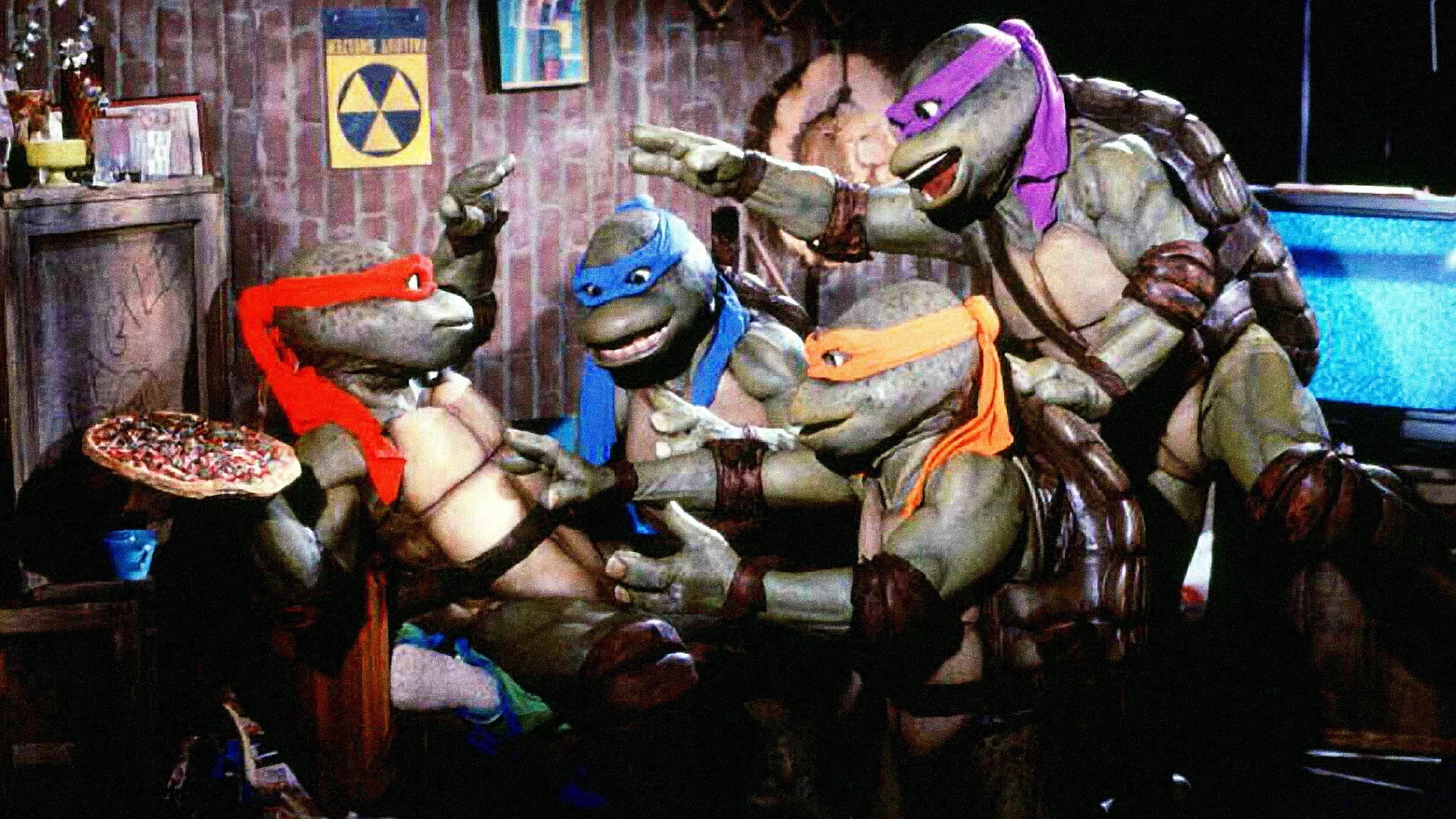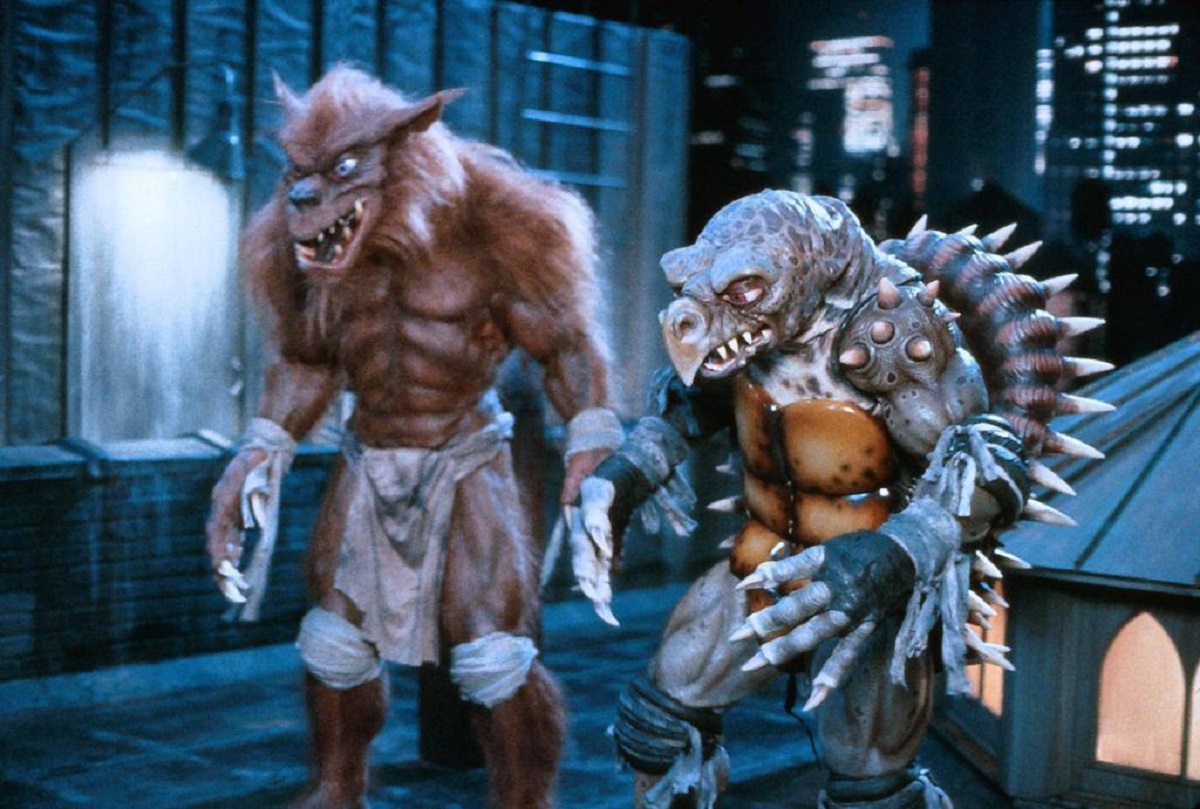USA/Hong Kong. 1991.
Crew
Director – Michael Pressman, Screenplay – Todd W. Langen, Producers – David Chan, Kim Dawson & Thomas K. Gray, Photography – Shelly Johnson, Music – John Du Prez, Animatronic Effects – Jim Henson’s Creature Workshop (Creative Supervisor – John Stephenson), Special Effects – Special Effects, Unlimited. (Supervisor – Joe P. Mercurio), Production Design – Roy Forge Smith. Production Company – Golden Harvest/Northshore Investments Ltd/Mirage Studios.
Cast
Kenn Troum (Raphael), Leif Tilden (Donatello), Michelan Sisti (Michelangelo), Mark Caso (Leonardo), Paige Turco (April O’Neil), Kevin Clash (Splinter), Francois Chau (Shredder), David Warner (Professor Jordon Perry), Ernie Reyes, Jr. (Keno), Toshishiro Obata (Tatsu), Mark Ghinter (Rhazar), Kurt Bryant (Tokkar), Raymond Serra (Chief Sterns)
Voices
Laurie Faso (Raphael), Adam Carl (Donatello), Robbie Rist (Michelangelo), Brian Tochi (Leonardo), Kevin Clash (Splinter), David McCharen (Shredder), Frank Welker (Rahzar/Tokka)
Plot
Forced to move with the exposure of their sewer hideout, the Turtles are now staying with April O’Neil. Shredder meanwhile reappears to take back command of The Foot. April covers a news story where Professor Jordon Perry of TGRI is disposing of buried nuclear waste. Splinter realises that this was the same radioactive material that created the Turtles. Shredder sends Foot agents out to steal the only-remaining vial of the nuclear waste. He then applies it to the most vicious animals he can find, a pit bull and a sea-turtle, to create creatures fierce enough to defeat the Turtles.
The Teenage Mutant Ninja Turtles were one of the major pop culture phenomena of the 1980s. Emerging out of a comic-book created in 1984 by Kevin Eastman and Peter Laird, they were quickly marketed and turned into an animated tv series Teenage Mutant Ninja Turtles (1987-96). This was a hit that launched the Turtles as a mass-market phenomenon. They were spun off into three live-action films beginning with Teenage Mutant Ninja Turtles (1990), followed by this and the subsequent Teenage Mutant Ninja Turtles III (1993). The first live-action outing of the Teenage Mutant Ninja Turtles was enjoyable fun but this second film seems strained.
One of the most ludicrous things surrounding the first film was the Moral Minority outburst at the level of violence and use of weapons by the Turtles. (In the UK, for instance, the animated show was retitled Teenage Mutant Hero Turtles presumably as the idea of animated ninja was too threatening for child audiences). Perhaps the most depressing thing about the sequel is that the studio has caved in to this hysteria and, as a result, the fight scenes come with a distinct lack of weaponry being waved and of impact in the kicks and punches thrown. The Turtles now go into battle wielding everything from sticks of salami, yoyos and garbage can lids or repeatedly use moves that involve them ducking and letting opponents knock each other out. The effect is somewhat akin to the scene in Amadeus (1984) where the ballet dancers prance about in silence without music because they have been forbidden to perform ballet.
The sequel lacks the infectious enjoyability that the first film had. The manic barrage of pop culture the Turtles represented has been taken from the cute to an unpalatable level ie. has simply been the opportunity for the film to turn itself into a marketing vehicle. David Warner’s scientist prominently displays a Bart Simpson glass – The Simpsons (1989– ) had just been started by the Teenage Mutant Ninja Turtles’ distributor 20th Century Fox and was becoming a big culture phenomenon. Even worse is when the Turtles burst into a nightclub in the midst of their climactic battle and come across white rapper Vanilla Ice and start dancing, even join him on stage in between their battle with the creatures, as he performs a number called Ninja Rap.

The problems extend elsewhere – the plot only serves to connect fight scenes and bring back old characters. It has a conceptual laziness that feels as though minimal effort has been made to do anything more than that. (It is a problem shared by all of the live-action Teenage Mutant Ninja Turtles films – take the Turtles out as characters and the films feel like insipid castoff Disney tv movies). Not to mention the bizarreness of the way the early 1990s computer systems are seen as working – the Turtles find a file that has been left open on the lab computer and try to access further details, resulting in bizarre technical claims like “If the database is coded, the whole system might go down.’
Still the Henson Creature Workshop and the mime artists succeed once again in turning the Turtles into some of the most engaging and dynamic creatures on the screen – the film opens on the title card “In memory of Jim Henson” who had just died in 1990. There is such a wild kinetic charge to the manic hip-talking characters that they end up carrying the film despite its deficiencies in almost every other area.
That said, the effectiveness of the characters does not extend to the two new creatures, Rahzar and Tokka, which only look like big cartoon animals brought to life rather than the monstrous creations they are supposed to be. Despite their build-up as major nemeses, the showdown with them and the Turtles is indifferent, while the dispatch of the giant mutated Shredder is a massive disappointment. Elsewhere, Elias Koteas’s Casey Jones from the first film (and a regular mainstay of the animated series and comics) has been written out in favour of a focus on a kid – Ernie Reyes Jr as a pizza delivery boy, who adds precisely nothing – in a clear targeting down to younger audiences.

The Turtles were subsequently revived in the live-action tv series Ninja Turtles: The Next Mutation (1997-8), which had the novelty of introducing a female Turtle Venus de Milo, but this was highly unpopular and lasted for only 26 episodes; a further animated series Teenage Mutant Ninja Turtles (2003-9); and the animated film TMNT (2007). Teenage Mutant Ninja Turtles (2014) was a live-action reboot from producer Michael Bay and director Jonathan Liesbesman and was followed by a sequel Teenage Mutant Ninja Turtles: Out of the Shadows (2016). This was followed by a further animated crossover film Batman vs Teenage Mutant Ninja Turtles (2019) ; a further animated tv series Rise of the Teenage Mutant Ninja Turtles (2018-20), which led to one film spinoff with Rise of the Teenage Mutant Ninja Turtles: The Movie (2022); and Teenage Mutant Ninja Turtles: Mutant Mayhem (2023). Turtle Power: The Definitive History of the Teenage Mutant Ninja Turtles (2014) is a documentary about the Turtle phenomenon.
Director Michael Pressman made a handful of other films with the likes of The Great Dynamite Chase (1976), The Bad News Bears in Breaking Training (1977), Boulevard Nights (1979), Some Kind of Hero (1982) and Doctor Detroit (1983). Since then, Pressman has been working as a director and producer in television. His one other film of genre interest was the quasi-ghost story To Gillian on Her 37th Birthday (1996).
Trailer here


